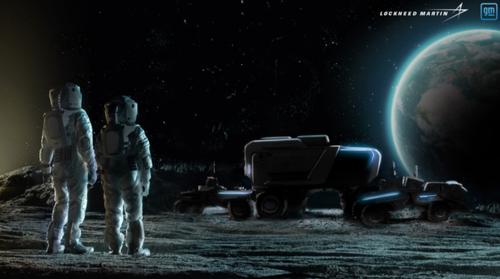Lockheed, GM Team-Up To Develop Next-Gen Lunar Rover For Astronauts
Lockheed Martin and General Motors are teaming to develop the next-generation lunar vehicle for NASA's upcoming Artemis missions to the Moon.
The Artemis program aims to land astronauts on the lunar surface by the midpoint of the decade. For exploration purposes, astronauts will need "surface mobility that is critical to enable and sustain long-term exploration of the lunar surface. These next-generation rovers will dramatically extend the range of astronauts," a Lockheed press release read.
The new lunar vehicle "may allow astronauts to explore the lunar surface in unprecedented fashion and support discovery in places where humans have never gone before," the defense contract continued.
"This alliance brings together powerhouse innovation from both companies to make a transformative class of vehicles," said Rick Ambrose, executive vice president, Lockheed Martin Space. "Surface mobility is critical to enable and sustain long-term exploration of the lunar surface. These next-generation rovers will dramatically extend the range of astronauts as they perform high-priority science investigation on the Moon that will ultimately impact humanity's understanding of our place in the solar system."
NASA's request for a next-generation lunar vehicle comes as GM, more than half a century ago, helped Boeing to create the Lunar Roving Vehicle (LRV) for the Apollo mission to the Moon in 1969.
"General Motors made history by applying advanced technologies and engineering to support the Lunar Rover Vehicle that the Apollo 15 astronauts drove on the Moon," said Alan Wexler, senior vice president of Innovation and Growth at General Motors. "Working together with Lockheed Martin and their deep-space exploration expertise, we plan to support American astronauts on the Moon once again."
GM will leverage its battery-electric technologies and propulsion systems to allow the rover to have a much greater range than the electric Apollo LRV. It will also incorporate autonomous, self-driving systems that will enable the rover to prepare for human landings, provide payload services, and allow astronauts to explore farther distances.
Lockheed Martin said the lunar rover is "being designed to traverse significantly farther distances to support the first excursions of the moon's south pole, where it is cold and dark with more rugged terrain."
Disclosure: Copyright ©2009-2021 ZeroHedge.com/ABC Media, LTD; All Rights Reserved. Zero Hedge is intended for Mature Audiences. Familiarize yourself with our legal and use policies ...
more



